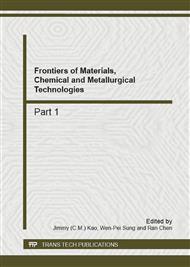[1]
K. C. Park, Y S. Kim, The effect of material and process variables on the stamping formability of sheet materials, Journal of Materials Processing Technology. 51(1995)64-78.
DOI: 10.1016/0924-0136(94)01578-o
Google Scholar
[2]
H. Sattari, R. Sedaghati, R. Ganesan. Analysis and design optimization of deep drawing process Part II: Optimization. Journal of Materials Processing Technology, 184 (2007) p.84–92.
DOI: 10.1016/j.jmatprotec.2006.11.008
Google Scholar
[3]
A. Assempour, E. Taghipour. The effect of normal stress on hydro-mechanical deep drawing process. International Journal of Mechanical Sciences, 53 (2011) p.407–416.
DOI: 10.1016/j.ijmecsci.2011.03.003
Google Scholar
[4]
J. M. Lee, D. C. Ko, K. S. Lee, B. M. Kim, Identification of the bulk behavior of coatings by nano-indentation test and FE-analysis and its application to forming analysis of the coated steel sheet , Journal of Materials Processing Technology. 120(2007).
DOI: 10.1016/j.jmatprotec.2006.11.130
Google Scholar
[5]
Shaohui Yin, Kejun Zhu, Yufang Wang. Numerical Simulation on Two-step Isothermal Glass Lens Molding. Advanced Materials Research Vols. 126-128 (2010) pp.564-569.
DOI: 10.4028/www.scientific.net/amr.126-128.564
Google Scholar
[6]
G. Gantar, K. Kuzman, B. Filipic. Increasing the stability of the deep drawing process by simulation-based optimization. Journal of Materials Processing Technology, 164–165 (2005) p.1343–1350.
DOI: 10.1016/j.jmatprotec.2005.02.099
Google Scholar
[7]
A. G. Mamalis, D. E. Manolakos, A. K. Baldoukas, On the finite-element modeling of the deep-drawing of square sections of coated steels, Journal of Materials Processing Technology. 58(1996)153-159.
DOI: 10.1016/0924-0136(95)02140-x
Google Scholar
[8]
Pedro Teixeira, A.D. Santos, F. M, Andrade Pires. Finite element prediction of ductile fracture in sheet metal forming processes. Journal of Materials Processing Technology, 177 (2006) p.278–281.
DOI: 10.1016/j.jmatprotec.2006.04.059
Google Scholar


